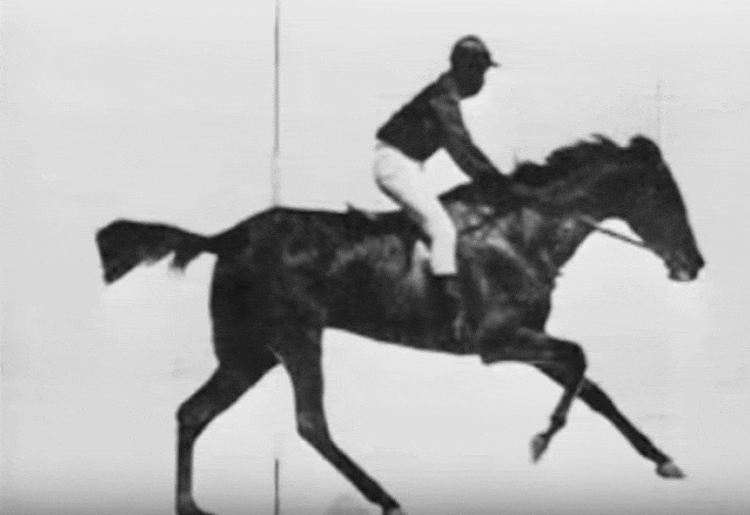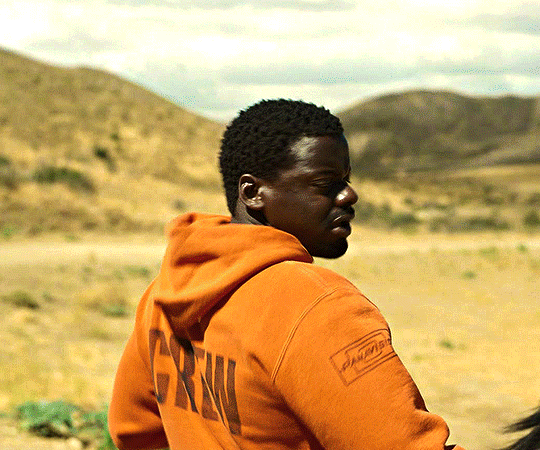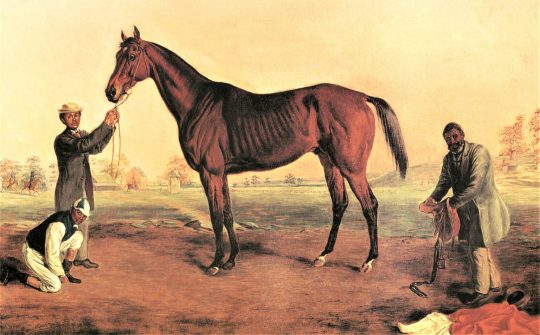#not really educated enough BUT ALSO if I am the only person posting 🏇 content on tumblr I can at least get other people started.
Explore tagged Tumblr posts
Text
History of Black jockeys in the USA: tumblr starter pack

The gif above was created by animating the motion study of “Annie G,” plate 627 of Eadweard Muybridge’s 1887 work, “Animal Locomotion”. The horse is a mare named “Annie G.” The jockey, unknown, is a Black man. It is one of the earliest motion studies on record, and captures some of the first humans and first animals to be recorded this way. (The earlier 1878 Muybridge study of the mare Sallie Gardener is more famous but you can’t really see the jockey.)
The Black jockey is referenced (fictionally) as an ancestor n Jordan Peele’s film Nope (2022) which also looks at the relationship between Black men, horses, and the consumption for entertainment of both of their bodies.

Fold into that what we are learning about today’s acceptance of the jockey-as-consumable, of their body as an accessory, of their wellbeing as mostly irrelevant; but then remember that once upon a time, people cared a lot more about horse racing. This is a big, tricky topic in American horse racing. There was a time in American history when Black jockeys were enslaved and forced into a job that we know is dangerous and consuming. Later there was a time in American history when Black jockeys were incredibly influential and important, competing equally alongside white jockeys, and they were deliberately pushed out of a sport they had mastered.

“The Undefeated Asteroid,” Edward Troye, 1864. Enslaved horse trainer Ansel Williamson, right, holding saddle. Ed Brown, jockey on left adjusting his spurs, was the young enslaved jockey. The groom is unidentified.
Press Keep Reading for an essay/signposts to resources. It’s intended as a jumping-off point for curious people and historians to learn more. TW for racial discrimination and discussion of weight.
As we know by now, jockeys are considered consumable/disposable by their sport; they are athletes whose names are less memorable than their mounts and their working conditions are tough. The sacrifices that jockeys make today to remain strong and light are hard enough when the jockey is willing. They have hard weight limits on their profession. And one of the very dark horrors of this was that young enslaved Black men of small stature and riding ability were singled out and used as jockeys. Their sacrifices would not have been willing. While this essay is about the Black athletes who willingly entered the sport post-abolition, I think it’s important to be up-front about the history of enslaved jockeys in America. Jockeys like Ed Brown (above) were forced into the job very, very young.
Horse racing is a bonkers calling, but it’s also one that people willingly follow. Post-abolition, there were many Black American jockeys who were incredible athletes, their records and statistics still impressive today. In a surge of excellence around the 1890s, Black jockeys rose to remarkable influence and power in America, becoming household names above even the horses, travelling the world, greeted with admiration, true celebrities with their faces on merchandise. At the very first Kentucky Derby, raced in 1875, 13 of the 15 jockeys were Black men.
Between 1890 and 1899, African American jockeys won the Kentucky Derby six times. By the early 1900s, they were history. The key push to exclude Black jockeys came when White jockeys began violently attacking their African American counterparts by boxing them out during races, running them into the rail, and hitting them with riding crops. These attacks prevented Black jockeys from finishing in the money, and endangered fragile and valuable racehorses. Soon after the attacks began, African American jockeys found they could not get rides. Anxiety over job insecurity appears to have played an important role in White jockeys’ actions: there were only a limited number of riding slots. White jockeys would have benefitted in any circumstances from the exclusion of Black jockeys, but in the late 1890s the US was in a depression, and unease about finding rides was especially high. Combined with a growing anti-gambling crusade that reduced attendance at racetracks and eliminated some tracks entirely, jockeys found demand for their services contracting.(National Bureau of Economic Research)
Professor Pellom McDaniels, describing the impact of this on legendary Black American jockey Isaac Burns Murphy:
MCDANIELS: If black people are supposed to be inherently inferior, to have someone who demonstrates success in material terms unravels this idea and therefore those whites during this time period who believe themselves to be inherently superior, something's broken in their psyches. And Murphy represents that kind of attack on white supremacy.

Isaac Burns Murphy, one of the best American jockeys of history, had an unprecedented rate of wins (something like 44% which is almost impossible.) he was born into slavery, but his mother managed to escape with him as a toddler to a Union Army camp. He was inducted into the Jockey’s Hall of Fame in 1955 and Eddie Arcaro was quoted, “there is no chance that his record of winning will ever be surpassed.” (How could it?!)
Today, the American Racing Museum honours many Black jockeys of history in their Hall of Fame, telling some truly incredible stories that are worth browsing.

Like James Winkfield. Born in America 1882, died France 1974. won the Kentucky Derby twice. Left America due to this rising backlash against the growing prominence of Black jockeys, the KKK in particular explicitly objecting to his celebrity and earnings by sending him death threats. Winkfield therefore rode and trained in Europe, settled in Russia, FLED THE 1919 REVOLUTION WITH 200 HORSES?, married an exiled Russian aristocrat (????) and, lest he know peace for five minutes, defended his horses from the European Nazi invasion with a pitchfork(!!!!). Fleeing WW2 to America, where the new racial segregation was now being widely embraced, Winkfield found hotels that had once welcomed the celebrity athlete suddenly turning him away (never forget that segregation was artificial and deliberate.) I am still stuck on him sneaking 200 thoroughbreds out of Russia. Here’s his Britannica article and Hall of Fame bio.
The campaign of racism and terror was successful at driving Black athletes from the profession, and Winkfield was the last Black jockey to win the Kentucky Derby. Jim Crow swept through the USA, and white people in the South comforted themselves with “lawn jockeys,” racist caricature lawn ornaments of Black men in jockey silks.
It wasn’t until the 1970s that Black jockeys began winning high-stakes races in the USA again.
Hopefully this has spurred (ha!) your interest. Here are some links if you find yourself interested in more!
American racing museum: Jockey hall of fame
Kentucky Derby Museum’s Black Heritage in Racing collection
How and Why Black Riders Were Driven from American Racetracks (summary paper, National Bureau of Economic Research)
There is no competition: the legacy of black jockeys (1975 entry in Sepia magazine preserved here. Note that James Winkfield’s picture incorrectly identified as Isaac B Murphy.)

This 1975 photo is from the article above and describes Cheryl Smith, “first Black American female jockey to hold a license.” I haven’t been able to find out much about her, but I’m not a historian - let me know if she takes your interest as a topic!
It looks like there are some big interesting books on the subject, though I haven’t read them myself. If you’re interested in doing a research project, here they are!
The Great Black Jockeys: The Lives and Times of the Men who Dominated America's First National Sport, by Ed Hotaling, 1999
Isaac Murphy: The Rise and Fall of a Black Jockey, by Katharine C Mooney, 2003
The First Kentucky Derby: Thirteen Black Jockeys, One Shady Owner, and the Little Red Horse That Wasn't Supposed to Win, by Mark Schrager, 2023.
#jockeyposting 🏇#this is a topic where I’ve tried to signpost to lots of resources instead of doing all the talking being quite conscious that I’m#not really educated enough BUT ALSO if I am the only person posting 🏇 content on tumblr I can at least get other people started.
996 notes
·
View notes